This post may contain affiliate links. If you use these links to buy something we may earn a commission. Thanks.
Shady spaces can be as useful as a full-sun field. From the delicious perennial vegetables to be discovered in this post, you’ll enjoy a lifetime of easy-growing nutritious food.
The best thing about growing edible perennials in the shade is the lack of weed competition. Once you remove what’s there, mulch the area, and plant what you want, weeds won’t be back anytime soon.
What’s even easier about shade-tolerant vegetation is you’ll rarely ever need to water them, especially if mulched.
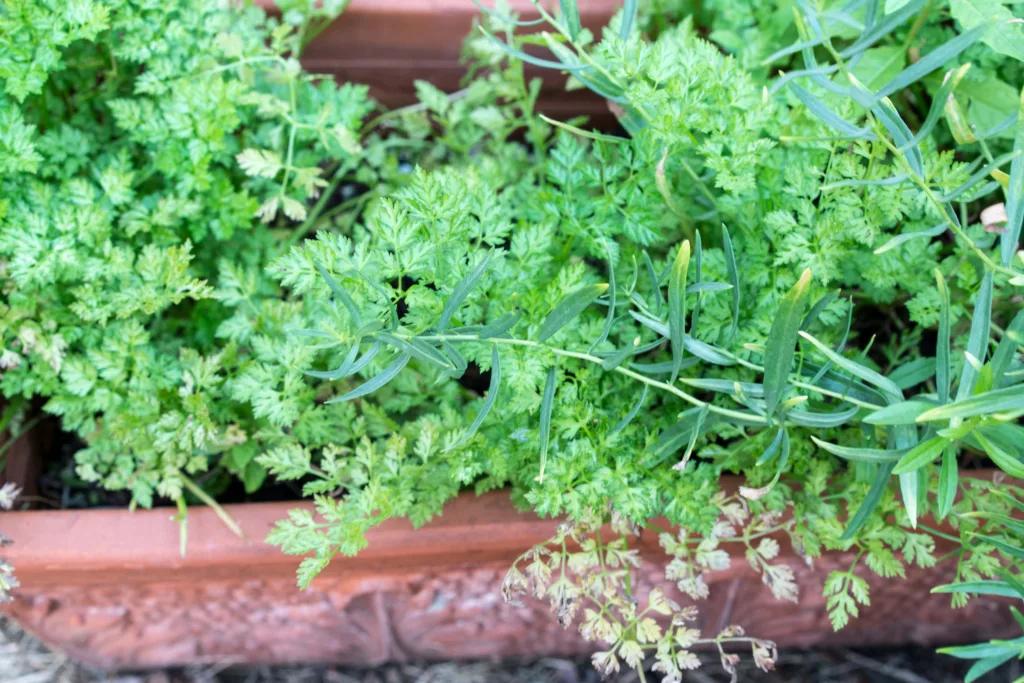
Disclaimer: Food Forest Living or its authors are not responsible for what you choose to consume. Do your own research before consuming as an “edible” or using any herb for medicine. Before planting any of these options check with your local invasive plant council or regional extension office for guidance on plants that may be invasive in your area.
It may seem your options are limited, but plenty of edible plants can grow in shade, even full shade.
In this post, you have 31 options for finding the best perennial vegetables that grow in shade.
You’ll find all the options for zones 3-11:
- If you’re in any zone above 6, you’ll be able to grow most options in this post.
- If you’re in zone 6, you’ll be able to grow everything in this post.
- If you’re in zone 5, you’ll be able to grow everything from the zones 3-5 sections.
- If you’re in zone 4, you’ll be able to grow everything from the zones 3-4 sections.
- If you’re in zone 3, only grow plants hardy down to zone 3.
To make the most of this post, write down the plants that spark your interest, then do further research about each one before deciding to plant it. Some plants may be more or less suitable for planting in your local area.
Many of these can be ordered on Seeds Now here, but most will be available locally.
What is the most shade-tolerant vegetable?
The most shade-tolerant vegetables are reserved for deep-shaded areas. If you have deep shade, as we do in some spots, you’ll also wonder what vegetables will grow best.
After researching, we planted all the shade-tolerant vegetables we could get our hands on and found what works, and what doesn’t.
Leafy greens, shoots, and roots, such as fiddleheads, caucasian spinach, chervil, hostas, wild ginger, and wild garlic, are all the vegetables you’ll find that grow in any kind of shade, even deep shade.
Each of these shade-growing vegetables looks gorgeous on the landscape too!
Other vegetables will tolerate more sun-kissed shades.
Types of shade

Before we begin, each plant may require or prefer a different type of shade.
And since perennials are planted once and permanently placed until their lifecycle expires, after years, you’ll want to plant them in an appropriate spot where they will thrive.
So as you scan this post, first understand the type of shade you’re planting in, and second, ensure the vegetables you choose are suitable for the position. I’ll let you know which position to plant each plant.
- Light shade
Most plants, in general, grow happily in light shade. Light shade is actually a decently sunny place and probably not an area that brought you to this post.
Shade-tolerant fruiting plants would do good in this situation. Plants that require full sun for fruit will produce fewer flowers in a lightly shaded area.
Light shade would be considered 4-6 hours of full sun.
Many vegetables in this post could grow in a lightly shaded area but will do much better in partial shade.
- Partial shade / Semi-shade
Partial shade is a great place. The majority of plants in this post will thrive here. This space has 3-4 hours of full sun and the rest of the day is shaded.
- Dappled shade
All plants in this post will grow well in dappled shade. This space is brightly lit with beems of sunrays shining in through dappled shade cast by a spacious canopy.
- Moderate shade
All plants in this post will grow here. This space recieves no direct sun, perhaps other than sun rise or fall, and is brightly lit in comparison to deep shade. We aren’t expecting any fruit from our vegetables, and in this space, you’ll only find edible leaves, shoots, and roots.
- Deep, heavy, or full shade
Many plants on the below lists can grow in full shade. This space sees no direct sun when the canopy is full, it’s generally dark, but you’ll still know it’s daytime! They may not thrive or grow as quickly as you’d hoped, but will still grow well and produce edible parts.
Perennial vegetables that grow in shade zone 3
The plants in this list can grow in much warmer zones, however, they are hardy all the way down to zone 3! The shade-loving list is the longest for zone 3, so it shows you that many shade-tolerant plants are hardy to the cold, too!
The best perennial vegetables for shade in zone 3 (and higher) are:
- False spikenard: zones 2-8
- Osha: zones 3-6
- Ramps: zones 3-7
- Rosybells: zones 3-7
- large campanula: zones 3-7
- Pink purslane: zones 3-7
- Labrador violet: zones 3-8
- Crinkleroot: zones 3-8
- Hosta: zones 3-9
- Chives: zones 3-9
- Caucasian spinach: zone 3-9
- Lovage: zones 3-9
- Ramps: zones 3-9
- Walking onions: zones 3-10
Before moving on to zone 4, I’ll provide a description and picture of each!
False spikenard (Smilacina racemosa) zones 2-8
Otherwise known as false solomons seal. Native to North America. Plant in full shade, moderate shade, dappled shade, or semi-shade. We have this growing natively all over the woods. If you want a shade-tolerant asparagus substitute this could be a good pick for you.
Osha (Ligusticum canbyi) zones 3-6
This perennial is an edible vegetable, so it’s worth mentioning, but maybe not best for everyone to intentionally plant in their garden or landscape.
This plant can be foraged in North America near streams, in meadows, or hiding between shrubbery. Grows in full shade, moderate, dappled, or semi-shade.
With the strong smell and flavor of spicy celery, it’s known for its medicinal properties, specifically, it’s antiviral for the respiratory system. The greatest caution with this plant is to not confuse identification with fatally poisonous look-alikes.
For more details and images see: Pages 204-205
To buy seeds PalmBeachSeedCompany sells them on Etsy.
Ramps (Allium tricoccum) zones 3-7
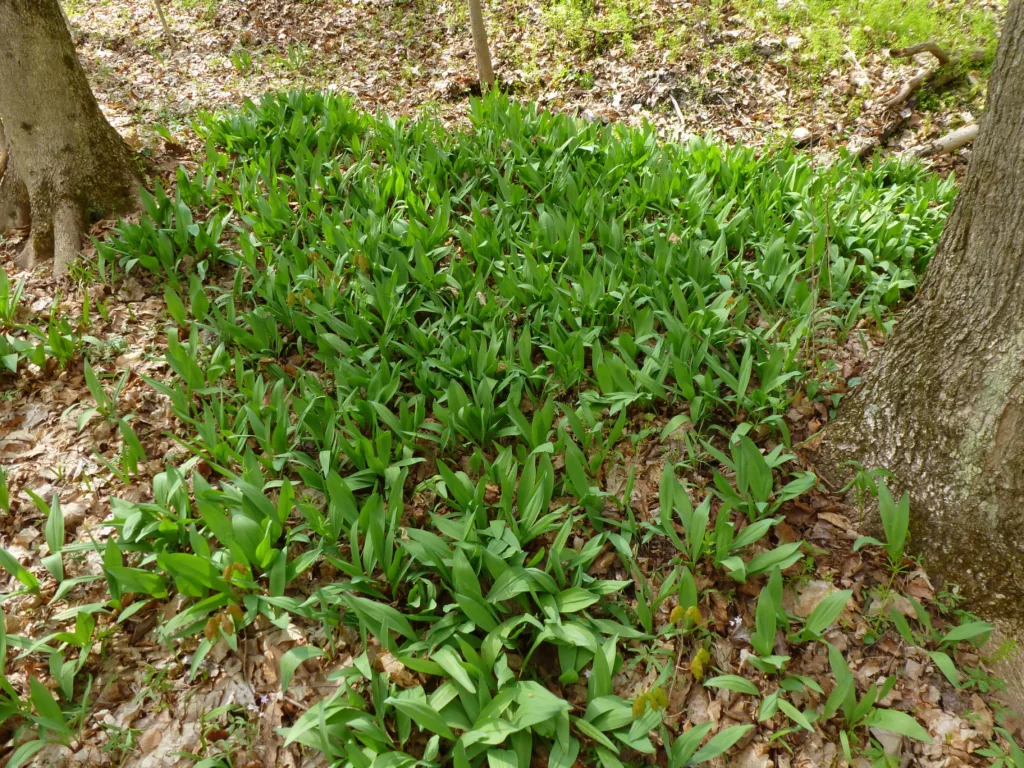
A best choice vegetable to grow in shade: A popular spring ephemeral found in Eastern North America and certainly worth growing—if you can get your hands on some seeds. I got my seeds from a friend, and you may be able to find seeds from local foragers in a foraging FaceBook group, or from here.
As an ephemeral, this plant will only be around for a short time in spring for harvesting. And as popularity rises, scarcity and value increase. When grown from seed they take 7 years before they can reproduce seeds. So establishing a ramp patch could take up to a decade, but is well worth doing, even to preserve this delicious species!
Plant under deciduous canopies in Eastern North American climates to cultivate your own patch of ramps. Get seeds at this Etsy shop.
The whole plant is edible, but the leaves are the best, and most sustainable to harvest. Make pesto, eat them sauteed, or flavor any dish in early spring as your storage room runs low on homegrown produce.
Rosybells (Streptopus roseus) zones 3-7
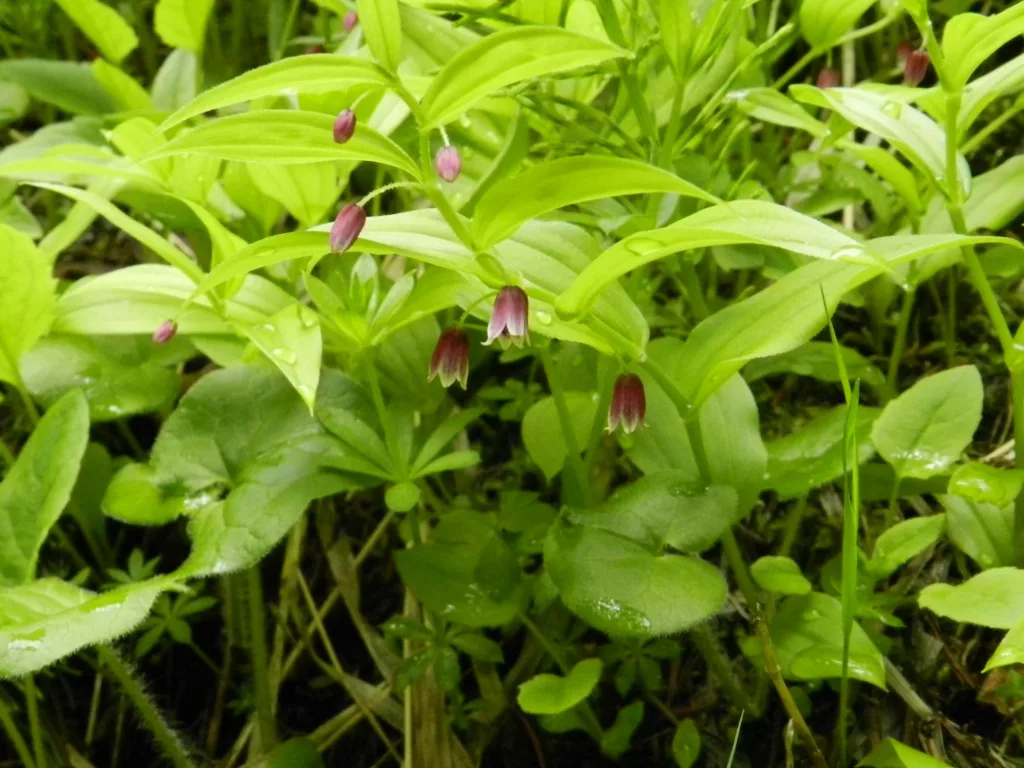
Thrives in damp shaded areas in Eastern North American climates.
Not suited for deep shade. Moderate, dappled, and semi-shaded positions.
Eat the leaves, shoots, and flowers.
A nice emerald green addition to the landscape with pretty pink bell flowers. A best choice for those looking for ornamental edible perennials.
large campanula (Campanula latifolia) zones 3-7
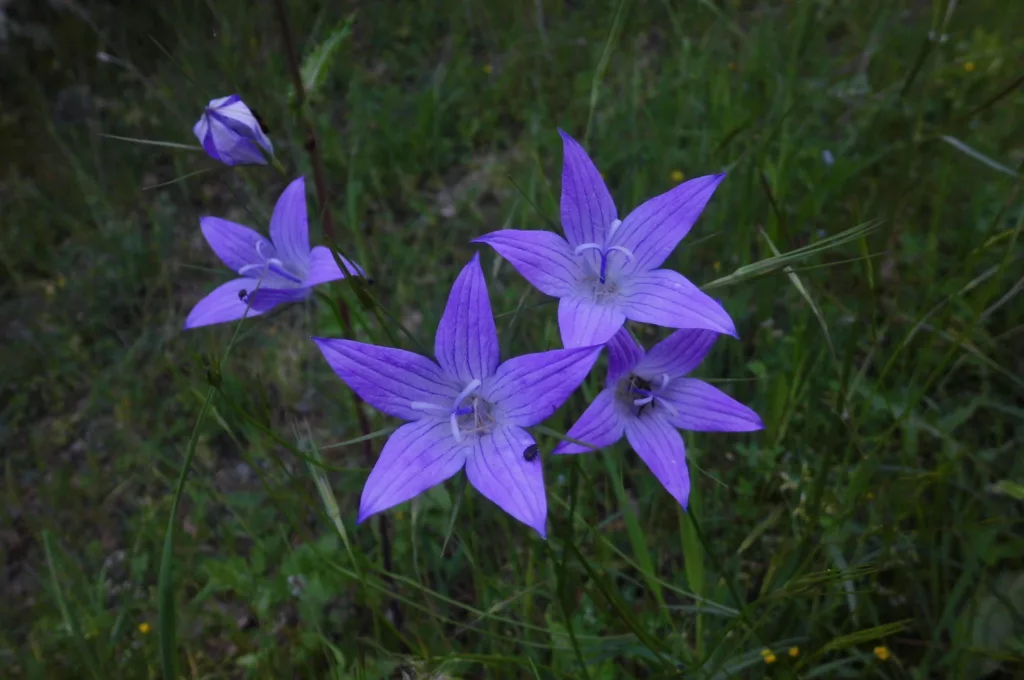
Native in Europe and Asia, but can be grown in any climate with the appropriate zone.
It can grow in full, moderate, dappled, and semi-shade.
Best choice for ornamental edible purposes. Eat the leaves, shoots, flowers, or roots. A nutritious and good-looking plant that grows up to 5 feet. But there are lower-growing varieties as well.
The large campanula grows bigger which means more substantial vegetation to consume. Order a pack of 20 seeds at this Etsy shop.
See: 12 Low-Growing (Low Maintenance) Edible Ground Covers
Pink purslane (Claytonia sibirica) zones 3-7
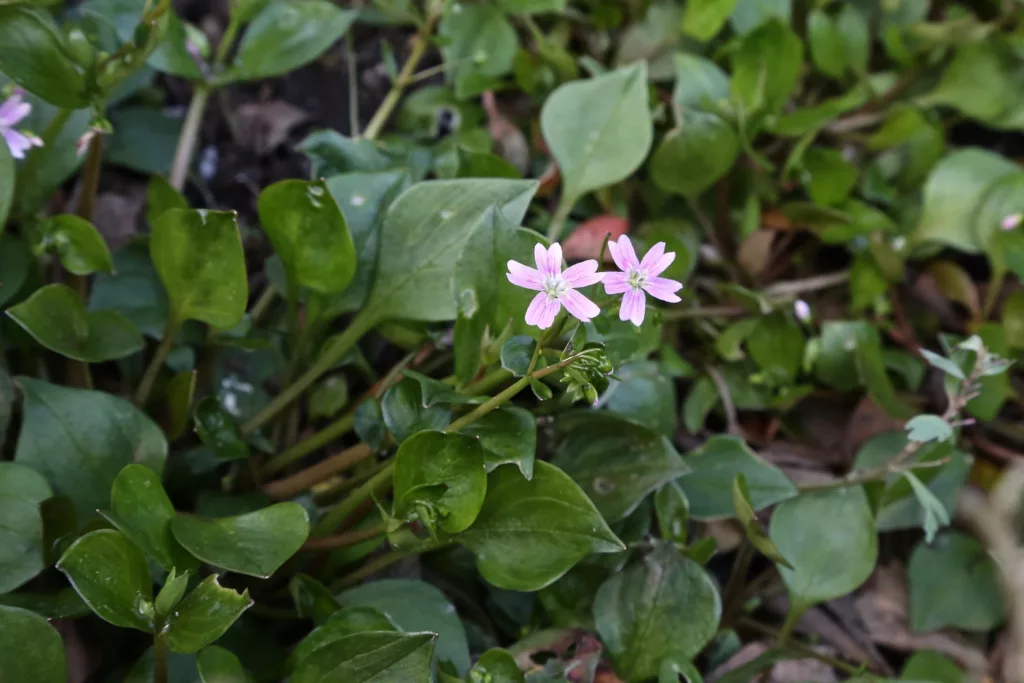
Native to Asia, and Western North America. Thrives in damp shaded areas. Suitable for full shade, moderate, dappled, and semi-shade positions—where they taste best!
Leaves are commonly eaten raw in salads. If you enjoy beets, you’ll enjoy pink purslane! Easy to harvest and grows easily.
A best choice for shade-loving, prolific, ornamental, and easy edible perennials.
Labrador violet (Viola labradorica) zones 3-8
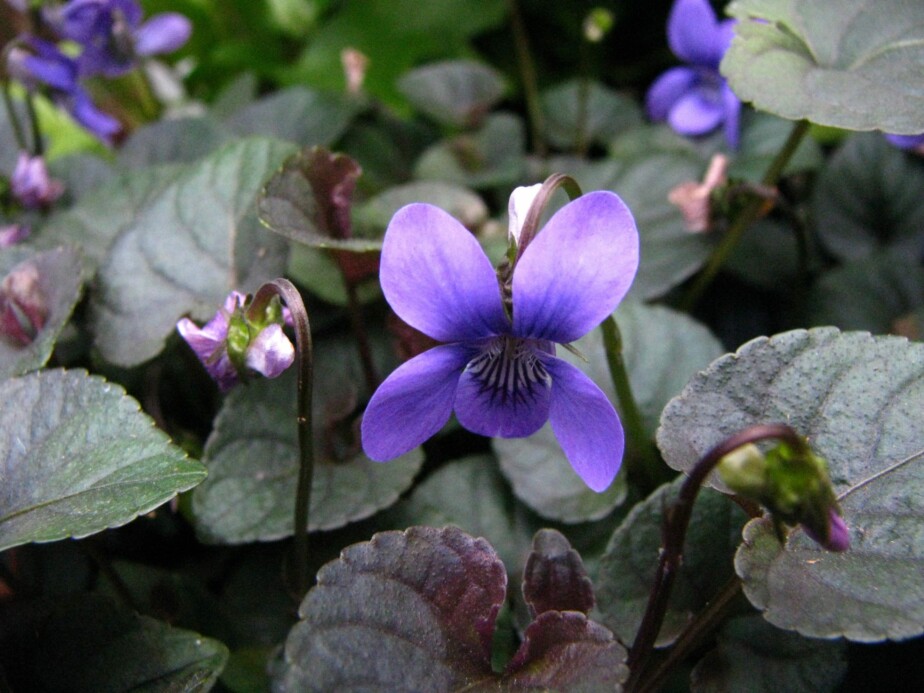
Otherwise known as Johnny Jump-Ups! Native to North-eastern North America.
Grows in full sun to full shade. Best in semi-shade, but easily spreads, so full shade keeps it under control.
The flowers and young leaves are edible and cute! We find the leaves similar to okra in texture with a mild flavor.
It grows into a thick ground cover and is often used as a compost crop when it gets out of hand.
A best choice for ornamental and edible purposes.
Crinkleroot (Dentaria diphylla) zones 3-8
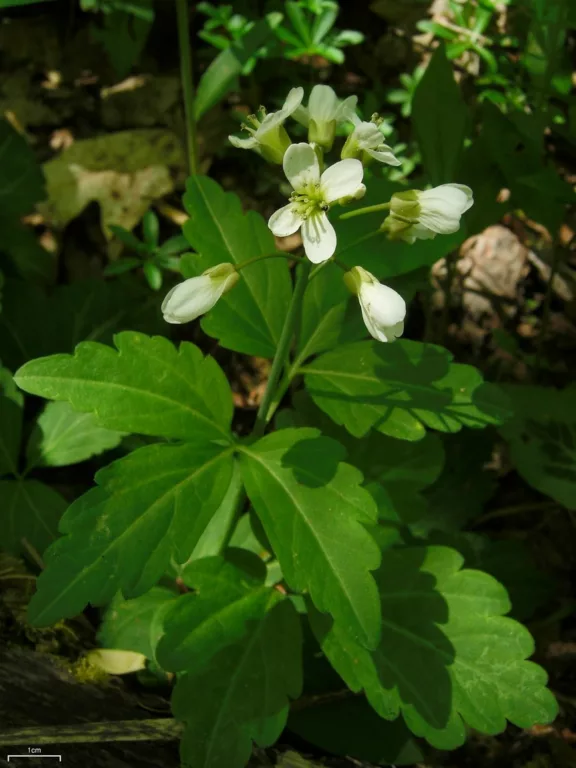
Native to Eastern North America. Grows in moderate full shade, dappled shade, and semi-shade.
Eat the leaves or the roots! Crispy and spicy like radishes.
Great as a fermented relish, or cooked. We cook many of our radishes to enjoy them in a non-spicy state and treat these the same.
Hosta (hosta) zones 3-9

As you may know, hosta shoots are edible and resemble asparagus! If you didn’t know, they are a must-try! Hostas are a delicious and easy spring food to grow and harvest that you’ll surely beat the deer to eating.
All hostas love at least semi-shade. Most varieties can thrive in full shade. ‘Elegans’ is a popular shade-loving variety of hosta. You can buy it from local nurseries or order it at this Etsy shop if convenient.
A best choice perennial vegetable for ornamental, easy, and edible purposes.
Order deer-resistant shrubs, herbaceous perennials, bulbs, roses, and ground covers all in one place.
Chives (Allium schoenoprasum) zones 3-9
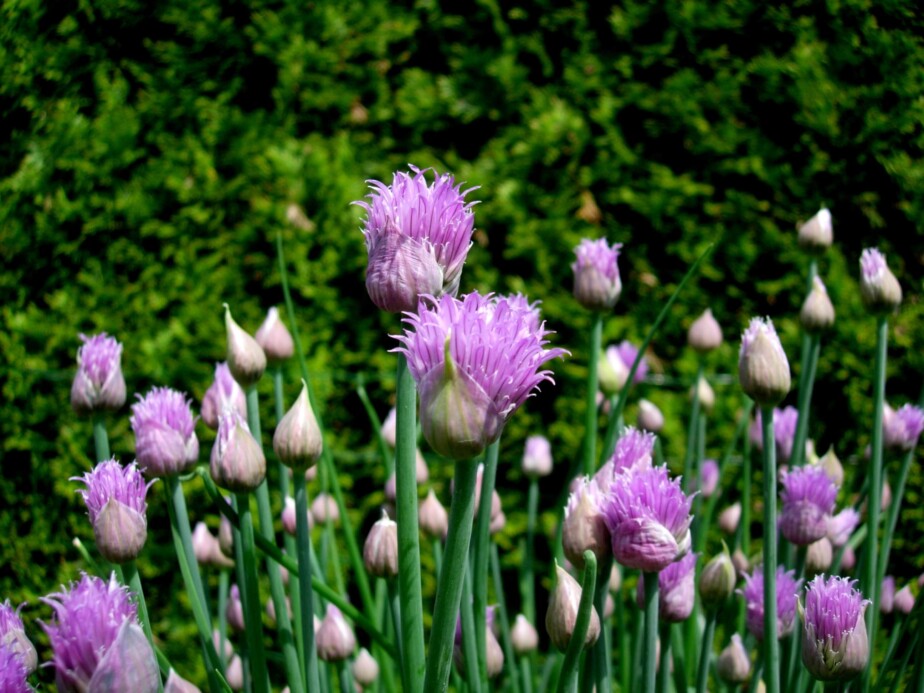
While you may know chives want full sun, they grow well in semi-shade, dappled, and moderate shade for us.
A best choice vegetable for flavoring, no-fuss growing, and beautiful flowers.
Chives easily and rapidly reseed themselves if you don’t cut the seed heads after the flowers expire.
Caucasian spinach (Hablitzia tamnoides) zone 3-9
A shade-loving vine with edible mild-tasting leaves.
Native to Europe and Asia. Grows in full shade to semi-shade.
Eat the plentiful shoots and leaves all spring and summer.
A best choice for salad lovers looking to replace the labor of annual spinach.
Lovage (Levisticum officinale) zones 3-9
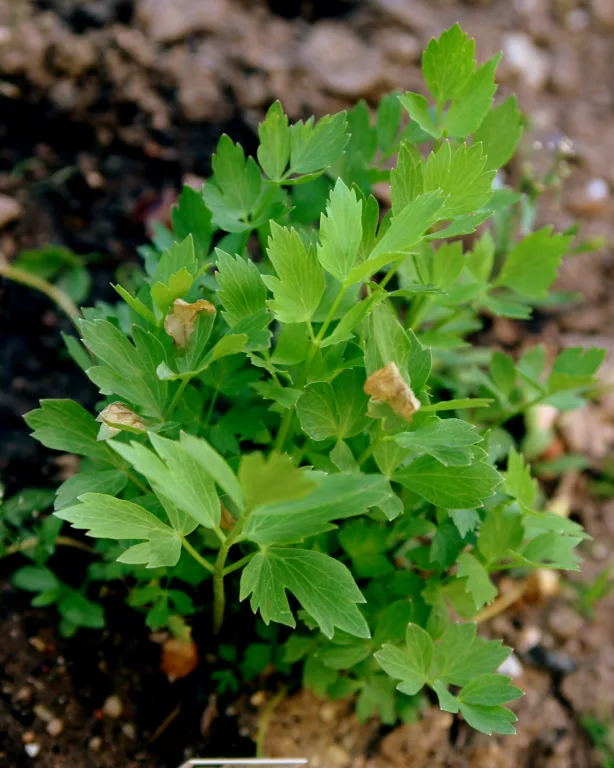
Lovage grows tall, very tall. It looks a lot like giant celery and tastes like a strong lemony celery so you’ll only need to use very little of the plant for flavor.
We love the look of our lovage and it gets big points for the looks, but the strong flavor deters us from using it often or abundantly in meals. It does seem to be deer resistant. I haven’t seen the deer chomp them down yet.
Lovage grows well in moderate shade to semi-shade.
I got our lovage from my grandmother-in-law who thought it was pronounced “la-vaj” but you can order seeds here at this Etsy shop or from SeedsNow if unable to find them elsewhere.
Walking onions (Allium proliferum) zones 3-10
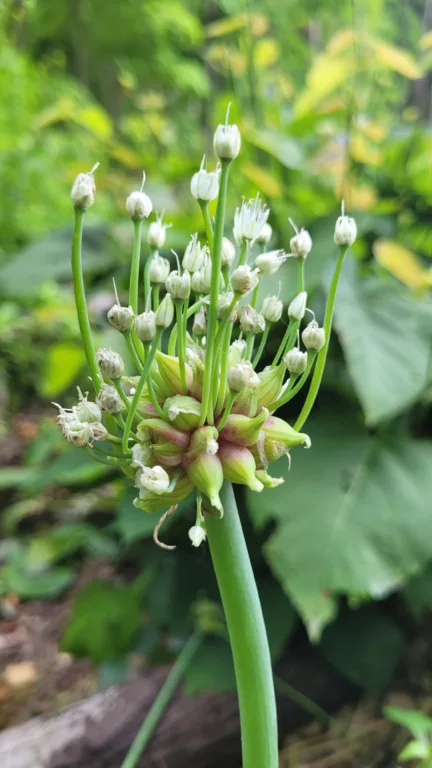
Walking onions are pretty cool. We got about a hundred bulbils from our family friend to plant, and now have endless green onions every year, plus they are walking around and becoming more onions!
The bulbils on the top of the stem (pictured) eventually get heavy enough that the stem bends and falls over. Once they touch the ground, they’ll root into new onion plants. And all those new onions will eventually take a step too!
A best choice perennial vegetable for passive easy growing, and interest.
Walking onions grow well in moderate, dappled, or semi-shade.
To order Egyptian Walking Onions directly from me, provide a Canadian delivery address and email: [email protected] with the subject “order.” Let me know how much you want and I’ll get back to you. If It’s easier, Exoticrareseeds sells bulbs too.
Perennial vegetables that grow in shade zone 4-10
Zone 4 growers can grow everything in Zone 3, plus the following nine shade-loving vegetable choices below.
- Good king henry: zones 4-8
- Wild garlic: zones 4-8
- Wild cucumber: zones 4-8
- Wild sarsaparilla: zones 4-8
- Fiddleheads: zones 4-9
- Day Lily: zones 4-9
- Hog peanut: zones 4-9
- Udo: zones 4-9
- Skirret: zones 4-9
- Nettle: zones 4-10
Good king henry (Chenopodium bonus-henricus) zones 4-8
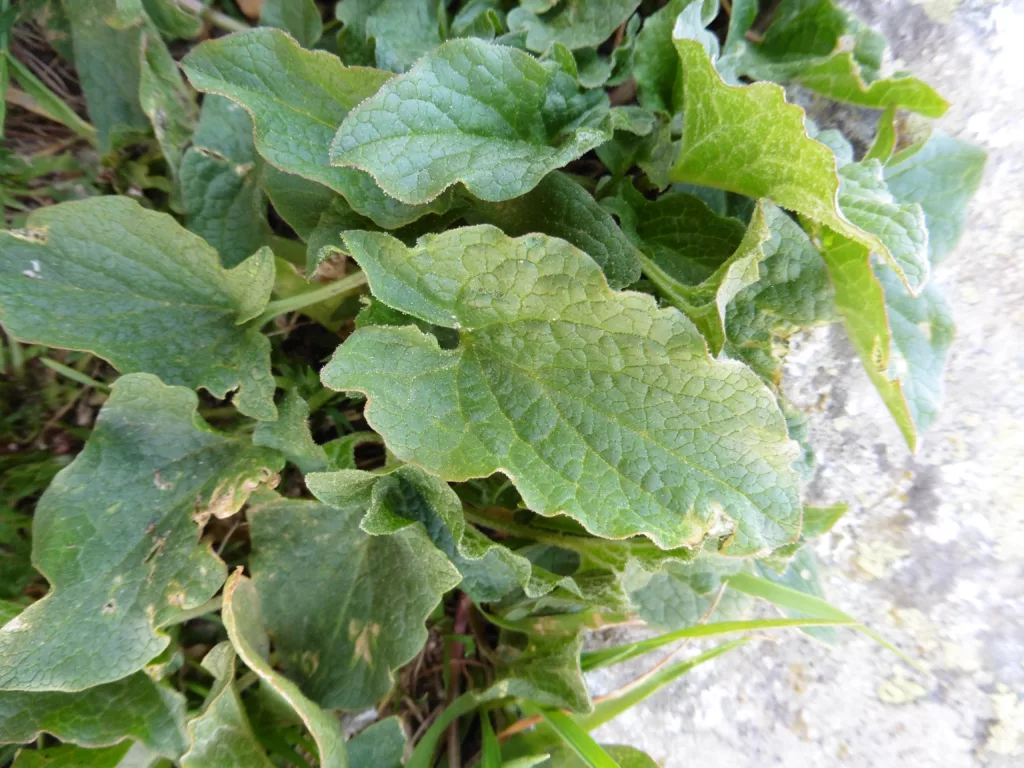
Plant Good King Henry in partial or lightly dappled shade. This tasty green is not suitable for deep shade.
Eaten primarily for the leaves, shoots, and flowers. Seeds can also be eaten but are not as good or substantial as the shoots or buds!
The leaves are a nutritious substitute for cooked spinach as they are best not eaten when raw. The shoots and buds are our favorite —shoots are eaten like asparagus and buds are eaten like capers if you ferment them!
A best choice for asparagus lovers who want to diversify their plants. This Etsy shop sells seeds with good germination reviews and free delivery.
Wild garlic (Allium ursinum) zones 4-8
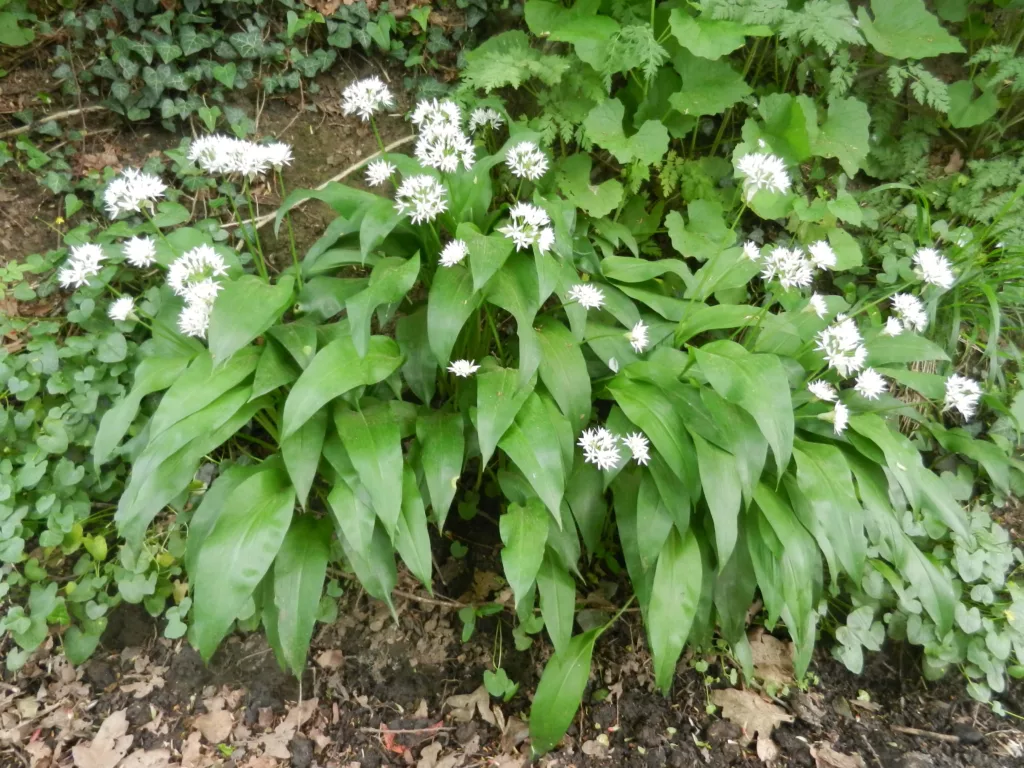
A best choice for ornamental value and edibility. Seeds are sold at this Etsy shop.
Eat the leaves, bulbs, shoots, or flowers. This crop is versatile for year-round eating as the fresh greens offer a mild garlic flavor and the bulbs (roots) can last in storage for 6-8 months.
Alliums generally like full sun conditions. Wild garlic, however, grows well in partial shade. Dappled and moderate shade may be tolerated. These are not suitable for full or deep shade.
Wild cucumber (Streptopus amplexifolius) zones 4-8
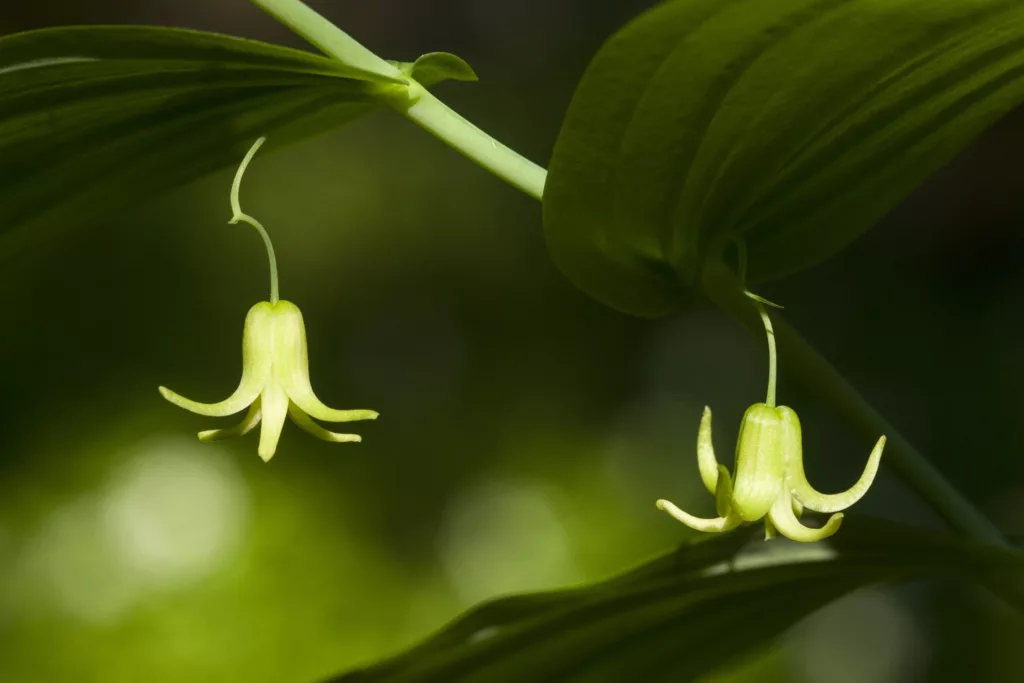
Wild cucumber is a nice addition to a polyculture mix of plants. It doesn’t have a lush habit but grows well under heavily shaded canopies. A good choice for deep, full, and moderate shade where options are more limited.
The roots, shoots, and leaves are edible. If you’re into fruit, you can also eat the fruit! They produce small berries with a mild cucumber flavor. SeedVillleUSA is the only place I’ve found them for sale by seed—they call it “watermelon berry.”
We tried them once, as we have them growing in our woodlands, but haven’t bothered to harvest them again since we have so many of the following delicious options…
But at least we know we have them to eat in case we needed survival food. Be sure to identify them properly and not mix them up with other similar-looking species.
Wild sarsaparilla (Aralia nudicaulis) zones 4-8
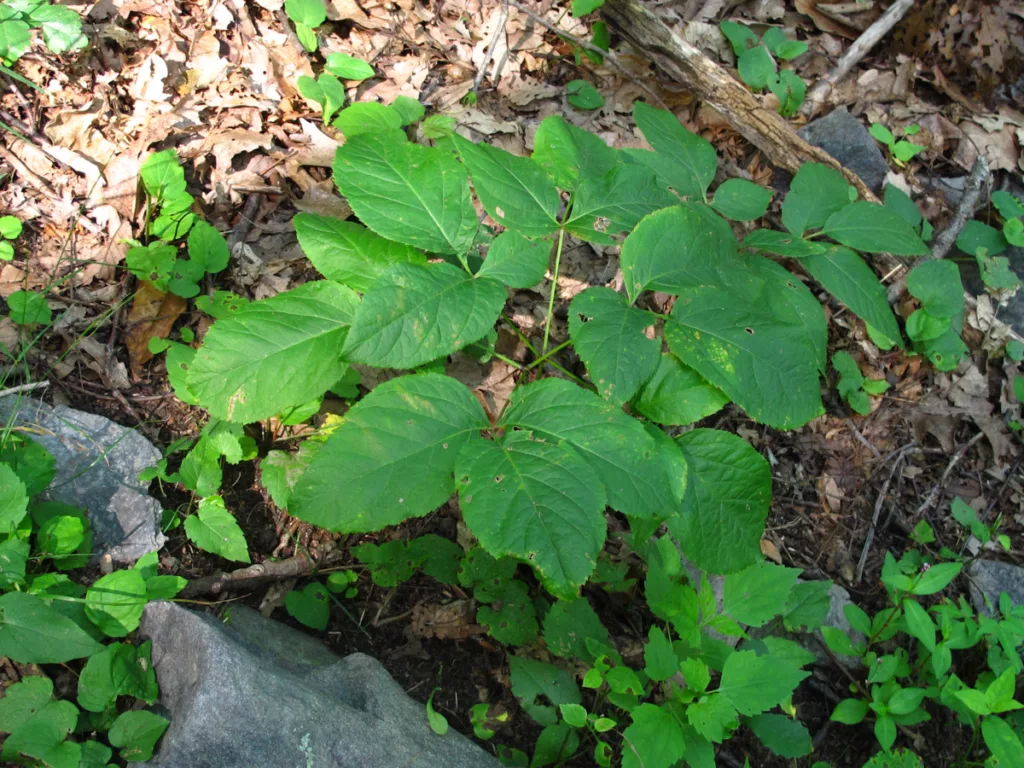
Wild sarsaparilla grows everywhere in our woodlands like a jackpot of food! Native to North America.
It grows to about a foot tall, and is used as an ingredient to make root beer.
Sarsaparilla grows in deep, full, moderate, dappled and partial shade.
Eat the leaves, roots, shoots, and fruits! We haven’t eaten any yet, but we will be harvesting some roots this year to try sarsaparilla tea. The leaves and shoots can be sauteed and eaten, and fruit can be made into jam.
Fiddleheads (ostrich ferns) zones 4-9
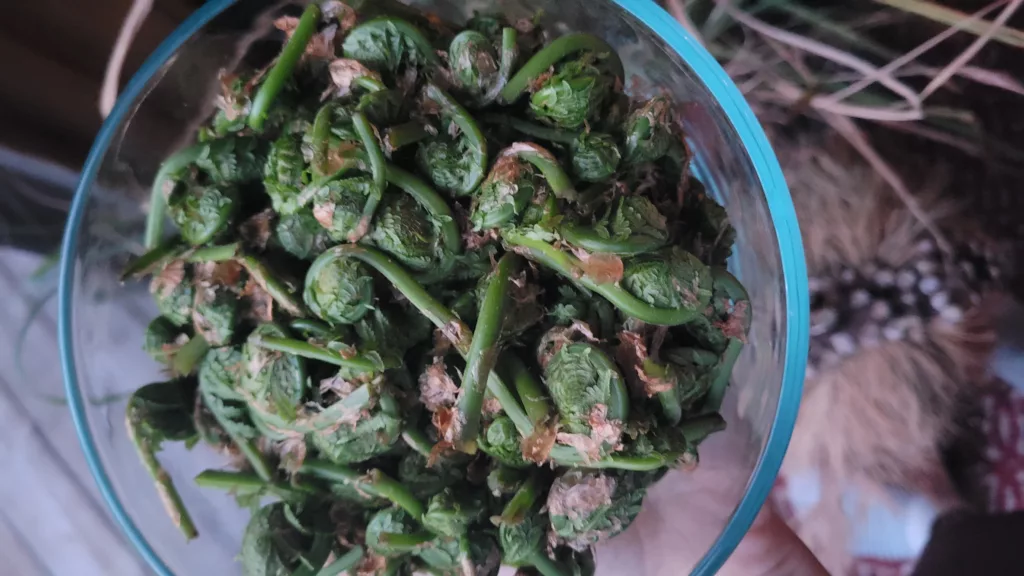
Fiddleheads are the unfurled leaves of ferns. The non-toxic species are ostrich ferns. Other species of ferns aren’t generally harvested for consumption as many contain carcinogenic compounds.
So don’t just plant or harvest any fern and expect to eat them! Identify or buy ostrich ferns!
Grow them in full, moderate, dappled, or partial shade.
We sautee or boil our fiddleheads for 5-10 minutes and enjoy. Don’t consume them raw.
You can buy live plants or start your own ostrich ferns from roots or from spores. This video shows how it’s done by spores, and plenty of Etsy shops have spores for sale.
Day Lily (Hemerocallis) zones 4-9
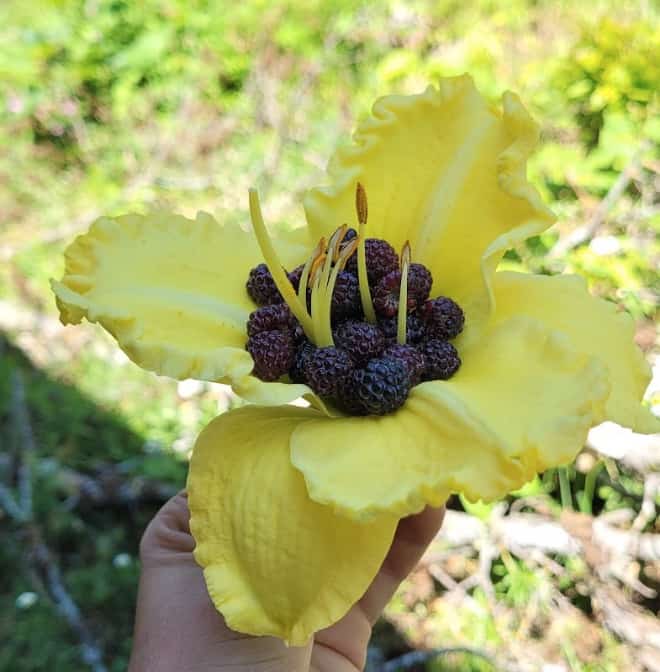
Daylily flower buds are very delicious! A light sautee and it’s a sweet plump bite of butter.
A best choice for ornamental value and deliciousness. SeedVilleUSA sells a variety of gorgeous daylilies.
Daylilies will produce fewer flowers in shade but tolerate moderate, dappled, and partial shade.
The whole plant is edible, but the best parts are the flowers before they open.
Eat them raw or lightly sauteed.
Hog peanut (Amphicarpaea bracteata) zones 4-9
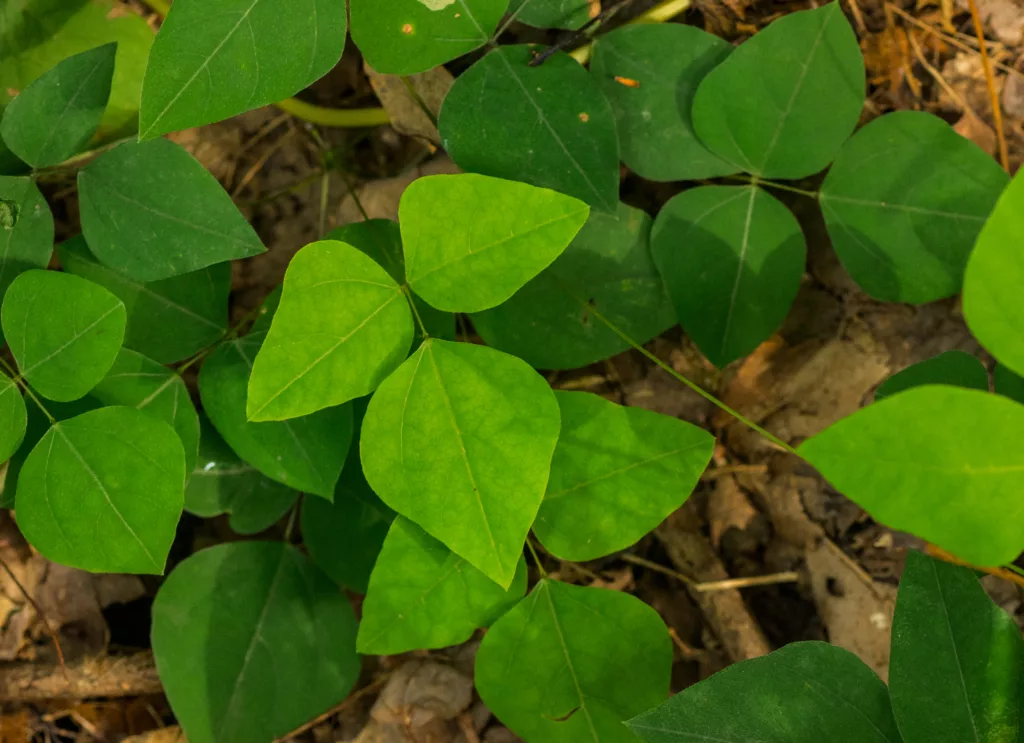
Hog peanuts are a cuter ground cover than they are a substantial vegetable. They are perfect for full and deep-shaded areas and also grow in moderate or dappled shade. They are a shade-loving (rather than tolerating) edible perennial.
They produce seeds in two places: just beneath the surface, and on their flowers.
Both seeds can be eaten!
The seeds above ground are small and quite insignificant. The below-ground seeds (or tubers) are also small, similar to the size of a single small peanut (without the shell).
We enjoyed tasting them. Our forests are covered in the sight of them; low-growing, cute, and vibrant foliage.
They are tedious to harvest but a handful will do, as a snack, like any other nut.
Udo (Aralia cordata) zones 4-9
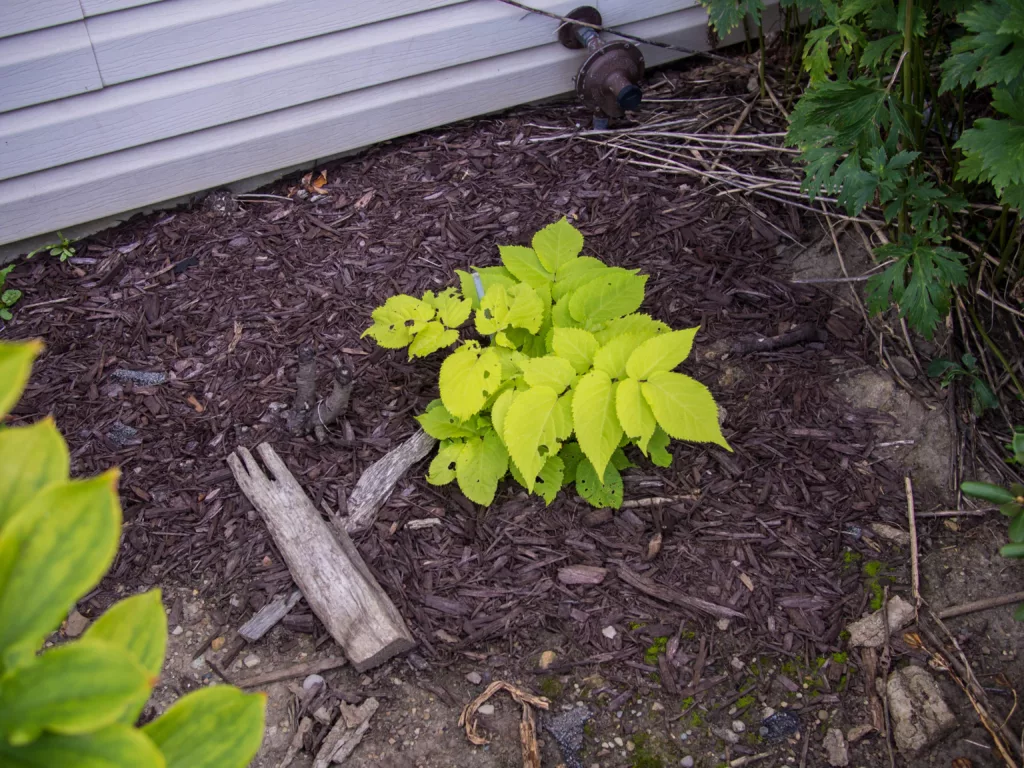
Also known as Japanese Spikenard. Native to Asia and often added to food forests. (It’s on our add-to-food-forest list).
Eat the leaves, shoots, roots, and stems. The shoots are most popular and the roots are often eaten like black salsify. (Love black salsify!)
This plant prefers moderate, dappled, or partial shade.
Seeds can be ordered here.
Skirret (Sium sisarum) zones 4-9
Parkrose Permaculture talks a lot of info about skirret! We have not gotten our hands on this perennial vegetable yet, but it is certainly on our list.
SmallIslandSeedCo sells Skirret seeds here.
A best choice for an edible vegetable that grows well in shade.
It does require a bit of work to cultivate for eating purposes and is a less passive choice than other options in this post.
Nettle (Urtica) zones 4-10
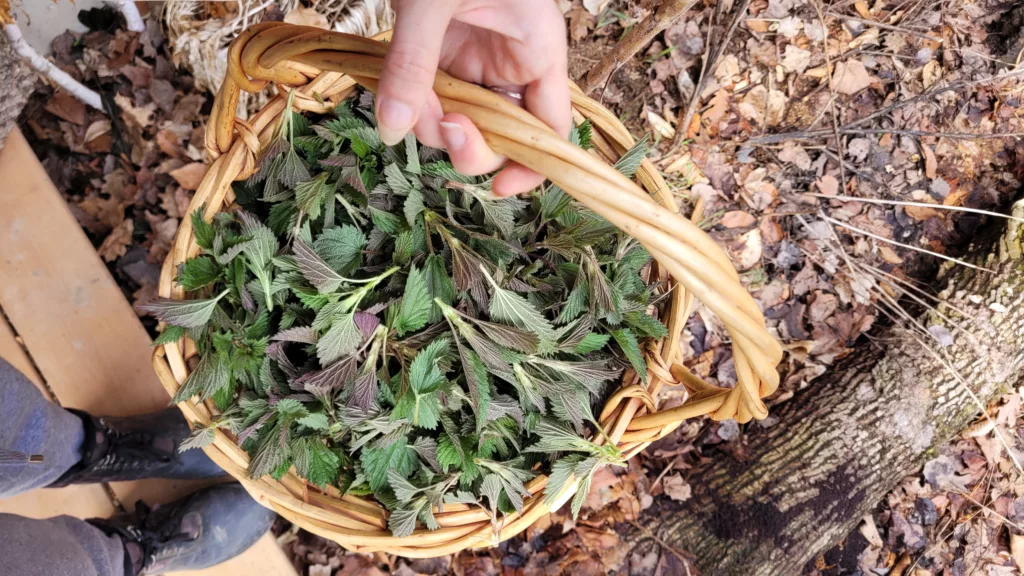
Although nettle is taking over my garlic this year, it’s one of my favorite shade-tolerant vegetables on this list.
It grows in moderate, dappled, and partial shade.
Eat the young leaves in spring. A best choice for cooked spinach lovers. If you wish to have a nettle patch for its endless benefits, SmallSeedIslandCo sells seeds on Etsy.
To do so, pinch the tops of emerging growth, especially in areas you don’t want nettle to be growing! Do this once a week and you’ll have a week’s worth of “spinach” but a more nutrient-dense version.
Nettle is actually called “stinging nettle” because the hairs of the plant will cause your skin to sting after you touch them.
Pick them with gloves and plant them away in a patch you won’t be walking by often.
To prevent spread, eat the seeds later in the season while they’re green. Pull them off and enjoy a nutrient-rich snack. They won’t sting!
Once you’ve harvested your seeds, chop the plants down to about a foot height and add them to your compost. Or make compost tea!
Perennial vegetables that grow in shade zone 5-11
In zone 5 you can grow all the plants in and above this section! Thats 28 plant options right there.
- Sweet woodruff: zones 5-9
- Chamelian plant: zones 5-10
- Szchechuan pepper zones 5-8
- Garlic mustard: zones 5-11
Sweet woodruff (Galium odoratum) zones 5-9

They look like lupin plants! But grow in deep, full, moderate, dappled, and partial shade.
Eat the leaves and flowers. Order here.
Native to Europe, Britain, and Africa.
Chamelian plant (Houttuynia cordata) zones 5-10
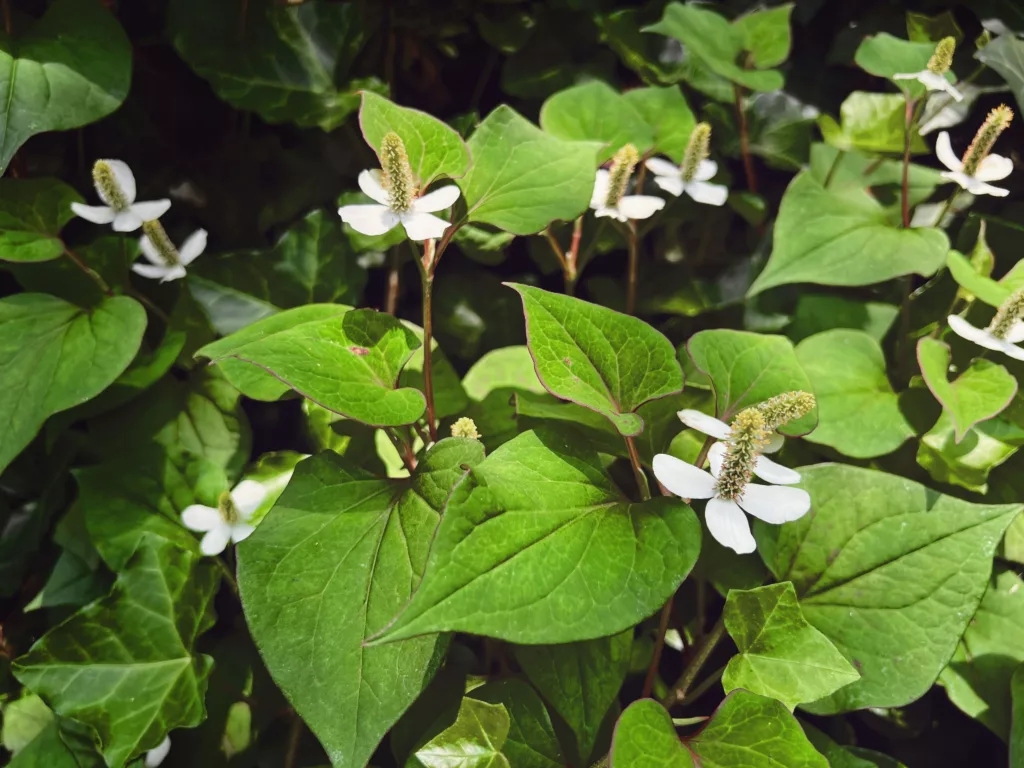
Edible roots, shoots, leaves, and flowers—basically the whole plant! Native to Asia.
Like all the plants on this post, the chameleon plant is a nutritious addition to a shady landscape.
It grows in deep, full, moderate, dappled, and partial shade.
Like all plants, ensure they are not invasive to your area before ordering. This shop sells chameleon plant seeds.
Szchechuan pepper (Zanthoxylum simulans) zones 5-8
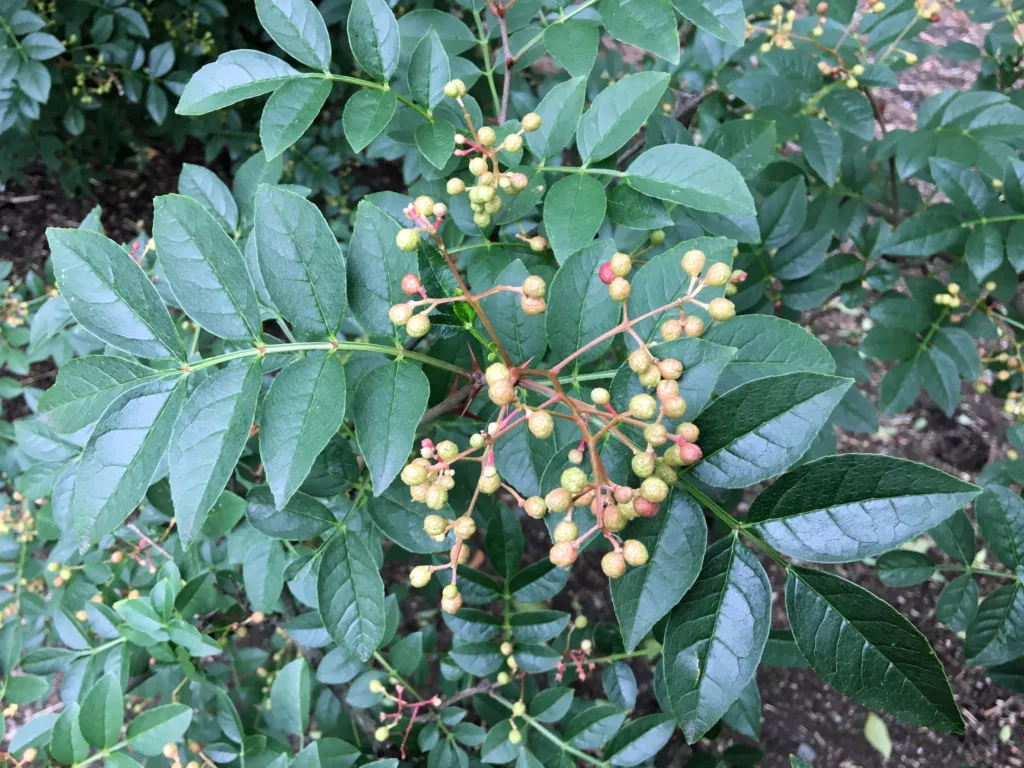
Popular in Asian cuisine, this flavor-boosting plant is a perfect addition to a shade-loving vegetable garden (and in 5 spice!)
Native to Asia. Seeds for sale at Ninaseeds.
This peppery plant can grow in deep, full, moderate, dappled, and partial shade.
Garlic mustard (Alliaria petiolata) zones 5-11

I don’t recommend planting garlic mustard intentionally. But if you see it, it’s edible, and delicious, but highly invasive. It’s invasive to the extent that it creates unideal soil conditions for its neighbors so it can soon take over.
So if you have it, eat it to help keep it at bay! And don’t let it go to seed. It’s a biennial and people who have successfully got rid of garlic mustard let it grow until year two and chop it back so it doesn’t get to seed.
After that, it’ll die. By leaving the soil alone, you won’t encourage new seeds to sprout from before you found it.
It grows in full, moderate, dappled, and partial shade.
Perennial vegetables that grow in shade zone 6-11
In zone 6, you’ll be able to grow everything in this post, except for the few-flowered leek, now that I’ve added it!
- Chervil: zones 6-9
- Wild ginger: zones 6-10
- Miners lettuce: zones 6-10
Chervil (Anthriscus cerefolium) zones 6-9

We tried growing chervil, and it didn’t come back. That’s because we live in a Zone 5 climate.
You can still grow it as an annual if you really want it!
The truth about chervil, though, is that it isn’t actually a perennial. It’s a biennial—meaning it lives for 2 years.
It can reseed itself, or you can reseed it every other year.
It grows in full, moderate, dappled, and partial shade.
Eat leaves fresh or cooked.
Wild ginger (Asarum caudatum) zones 6-10
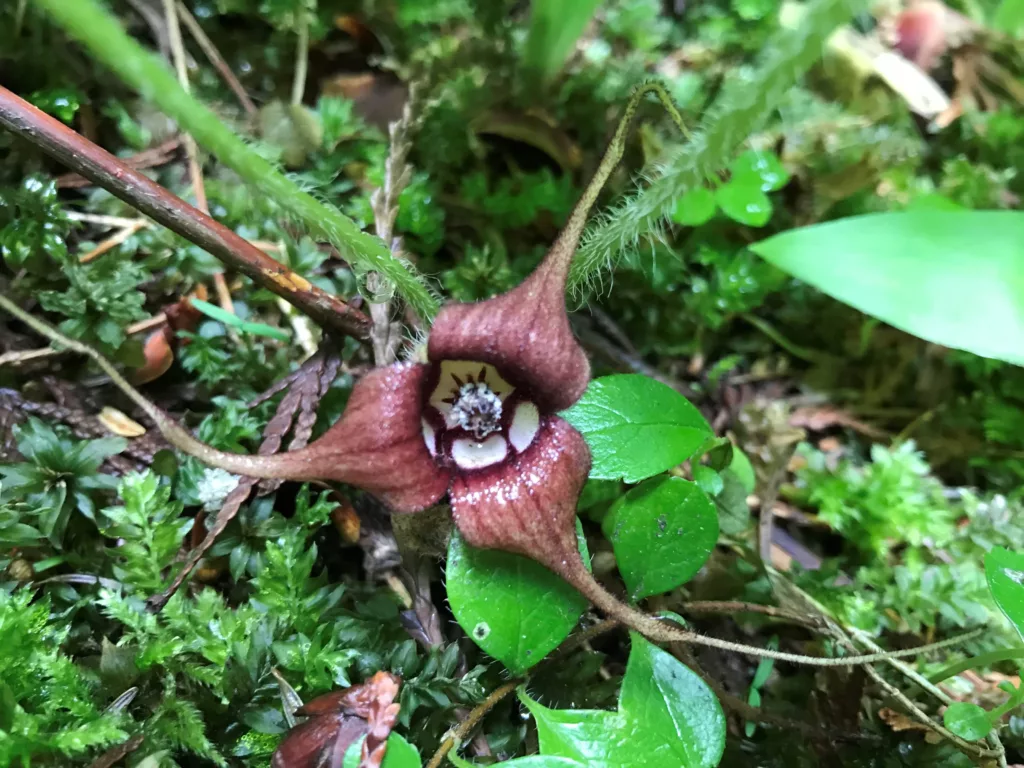
Wild ginger grows natively in Western North America. I got seeds from a local, you can do the same or get them here along with any other orders.
Use the root or leaves as a ginger substitute in food or in tea.
It grows in deep, full, moderate, and dappled shade.
Perennial vegetables that grow in shade zone 7
- Few-flowered leek zones 7-10
Few-flowered leek (Allium paradoxum) zones 7-10
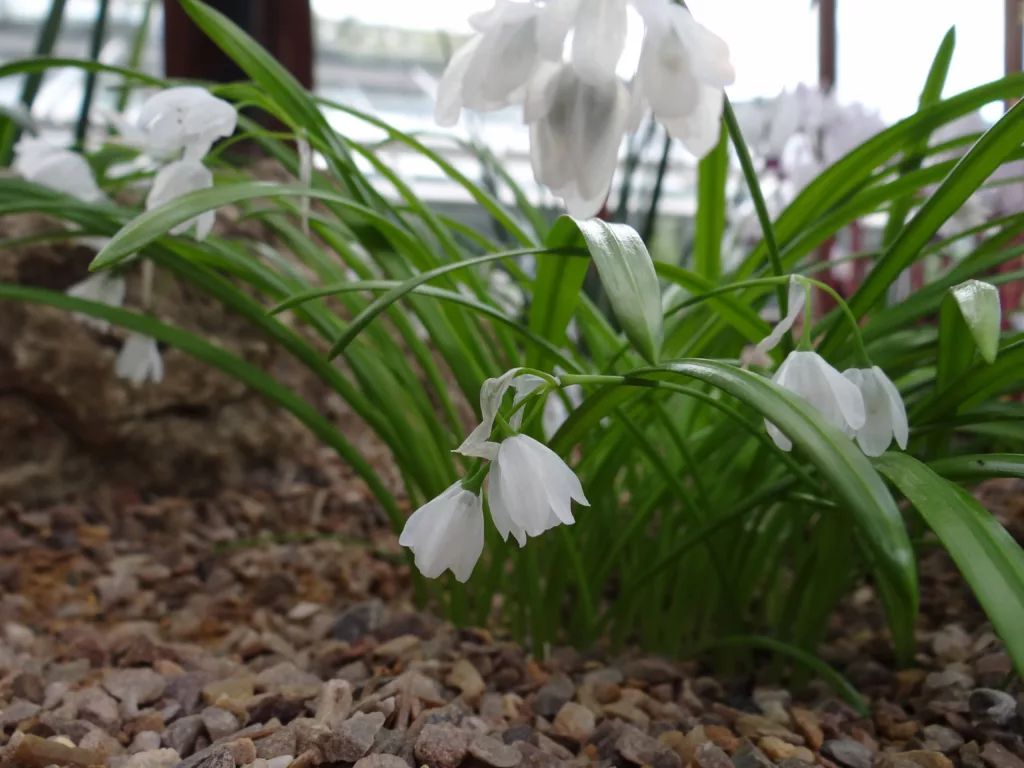
If you love leeks you can grow regular ones annually, but they will need full sun to grow well!
This leek, Native to Asia, grows in full, moderate, dappled, and partial shade.
The flowers, leaves, and roots are edible either raw or cooked.
Perennials that grow edible fruit in the shade
Coming soon!
Recent Posts
There’s no shortage of full-sun ground covers for zone 4 climates! Each plant in this list can withstand the frigid temperatures and also enjoy the hot sun in summer. Full sun means that a plant...
There's no shortage of full sun ground covers, not even in zone 3! Zone 3 climates offer hot but short-lived summers and very cold winters. So each plant in this list can withstand the frigid...
